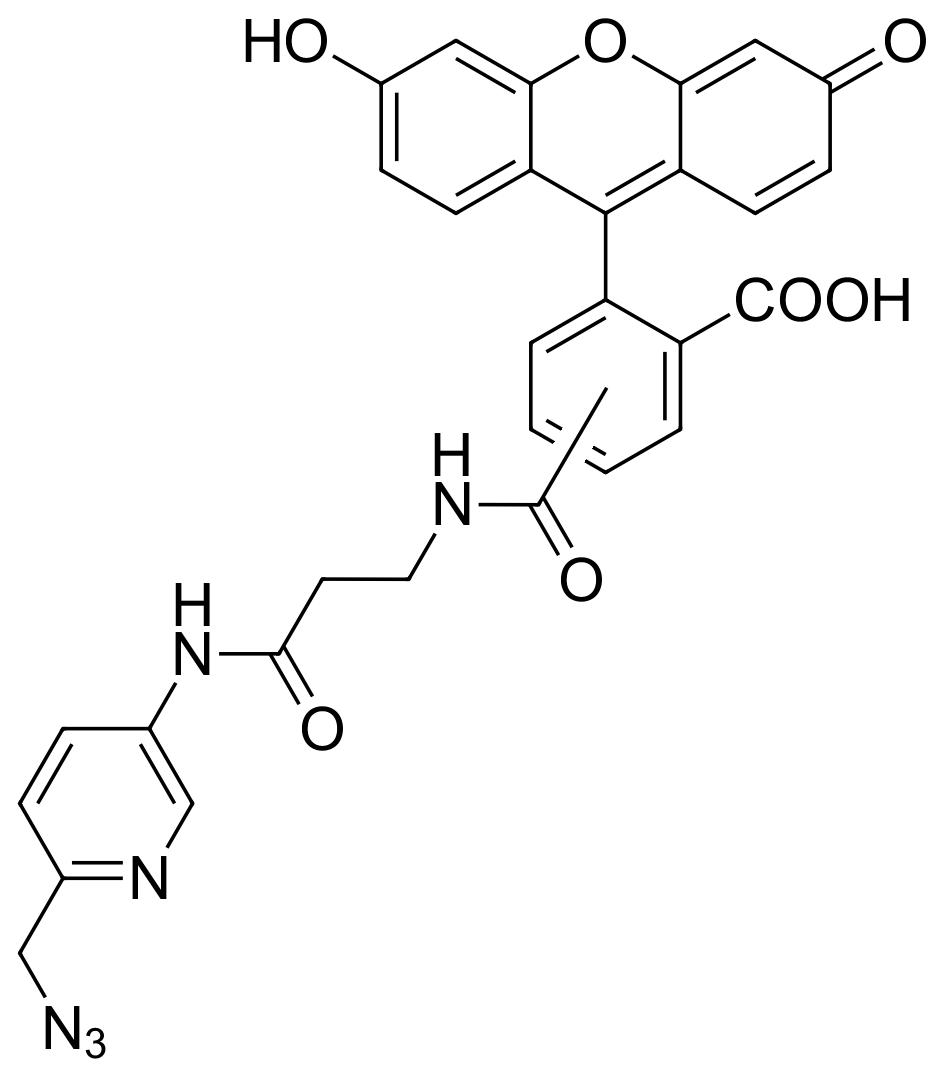6-FAM-Picolyl-Azide
High-efficiency green fluorophore for CuAAC with enhanced biocompatibility

-
6-FAM-Picolyl-Azide is an enhanced green-fluorescent dye based on the 488 nm excitation/emission range, optimized for efficient biomolecular labeling via copper-catalyzed azide-alkyne cycloaddition (CuAAC). Its picolyl group acts as an internal ligand that chelates Cu(I), increasing the local concentration of the catalyst and significantly accelerating the reaction. This enables efficient conjugation to alkyne-functionalized biomolecules by forming a stable 1,2,3-triazole linkage, while simultaneously minimizing copper-induced toxicity and damage to sensitive targets such as proteins, DNA, and RNA.
Traditional CuAAC typically demands high levels of copper, posing a risk to cell viability and molecular integrity—especially with delicate biomolecules like GFP-tagged proteins or nucleic acids. In contrast, picolyl azides dramatically improve reaction kinetics, allowing for selective and sequential labeling: first with the picolyl azide due to its enhanced reactivity, followed by other azides with distinct reactivity profiles [1].
Key Advantages
6-FAM Picolyl Azide, can be used for this advanced labeling strategy by:
- Enhancing the reaction Efficiency: The picolyl azide moiety enhances CuAAC kinetics by chelating Cu(I), increasing local reactivity and reaction speed.

- Low Copper Concentration Required: Enables labeling in live-cell and sensitive biomolecular systems with minimal cytotoxicity.
- Orthogonal Reactivity: 6-Fam-Picolyl-Azide can be used for labeling Proteins, Nucleic acids (DNA, RNA), Peptides, Lipides, sugars and it reacts preferentially with alkynes, even in mixtures containing other azides, ensuring high specificity.
- Versatile Biomolecule Compatibility: Suitable for labeling a wide range of biomolecules, including Proteins and peptides, DNA, RNA, and oligonucleotides, Lipids and sugars.
Bright Green Fluorescence:
Excitation: 490 nm
Emission: 510 nm
Compatible with standard FITC and AF488 filter sets for fluorescence microscopy and flow cytometry (FACS).
- High Photostability and Quantum Yield: Resists photobleaching during extended exposure, making it ideal for long-term imaging and high-sensitivity detection.
Applications
- Live-cell imaging of proteins or nucleic acids
- Post-synthetic oligo labeling
- Surface functionalization and glycan profiling
- Activity-based protein profiling (ABPP)
- Cell tracking and FACS analysis
- Tandem CuAAC labeling strategies (e.g. multisugar oligos)
Comparison with Standard Dyes
6-FAM-Picolyl-Azide offers a safer and faster alternative to traditional 6-FAM azide or FITC-based dyes. It combines high brightness with CuAAC enhancement, giving users a powerful tool for modern fluorescence-based labeling strategies.
Complementary Products:
baseclick also offers a comprehensive portfolio of 488 dyes for click chemistry applications, including:
LITERATURE
BONCAT-FACS-Seq reveals the active fraction of a biocrust community undergoing a wet-up event. Frontiers in Microbiology, 2023, 14, 1176751.
https://doi.org/10.3389/fmicb.2023.1176751
[1] Efficient Tandem Copper‐Catalyzed Click Synthesis of Multisugar‐Modified Oligonucleotides, Annika J. Tölke et al., 2024, Angewandte Chemie International Edition, Vol. 63(25), e202405161.
-
-
Molecular Formula
C30H22N6O7
-
Shelf Life
12 months unopened after receipt
-
Storage Conditions
-20 °C, dark
-
Molecular Weight
580.55 g/mol
-
Purity
≥ 95% (HPLC)
-
Physical State
yellow to orange solid
-
CAS Number
n.a.
-
Excitation (max)
490 nm
-
Emission (max)
510 nm
-
Ɛ (max)
76.000 cm-1M-1
-
Solubility
DMSO, DMF
-
Preparation/Handling
For a 10 mM solution add 172 μL to 1 mg.
For a 10 mM solution add 861 μL to 5 mg.
-
Molecular Formula

